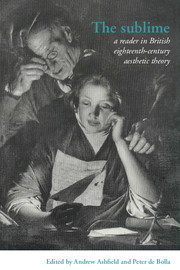Book contents
- Frontmatter
- Contents
- List of Abbreviations
- Introduction
- Part I The Longinian tradition
- Part II Rhapsody to rhetoric
- 11 The spectator, (1712-1714)
- 12 A discourse on ancient and modern learning (1734)
- 13 Characteristicks (1714)
- 14 The works (1724)
- 15 To David Fordyce, 18th June 1742
- 16 The pleasures of imagination (1744)
- 17 An essay on the sublime (1747)
- 18 Observations on man (1749)
- 19 Lectures on the sacred poetry of the Hebrews (1753/1787)
- 20 A dictionary of the English language (1755)
- 21 Conjectures on original composition (1759)
- 22 The art of speaking (1761)
- 23 A course of lectures on oratory and criticism (1777)
- 24 An enquiry concerning the principles of taste (1785)
- Part III Irish Perspectives
- Part IV The Aberdonian Enlightenment
- Part V Edinburgh and Glasgow
- Part VI From the Picturesque to the Political
- Sources and further reading
17 - An essay on the sublime (1747)
Published online by Cambridge University Press: 05 June 2012
- Frontmatter
- Contents
- List of Abbreviations
- Introduction
- Part I The Longinian tradition
- Part II Rhapsody to rhetoric
- 11 The spectator, (1712-1714)
- 12 A discourse on ancient and modern learning (1734)
- 13 Characteristicks (1714)
- 14 The works (1724)
- 15 To David Fordyce, 18th June 1742
- 16 The pleasures of imagination (1744)
- 17 An essay on the sublime (1747)
- 18 Observations on man (1749)
- 19 Lectures on the sacred poetry of the Hebrews (1753/1787)
- 20 A dictionary of the English language (1755)
- 21 Conjectures on original composition (1759)
- 22 The art of speaking (1761)
- 23 A course of lectures on oratory and criticism (1777)
- 24 An enquiry concerning the principles of taste (1785)
- Part III Irish Perspectives
- Part IV The Aberdonian Enlightenment
- Part V Edinburgh and Glasgow
- Part VI From the Picturesque to the Political
- Sources and further reading
Summary
Section I
We are now, Palemon, to treat of that kind of writing which of all others is the truly excellent and great manner, and which is peculiar to a genius noble, lofty, comprehensive. You will easily know I mean the Sublime, and perhaps tell me the task is difficult; I acknowledge it, especially when I consider that we have already a great author upon the subject, who has received the approbation of ages, and who, in the opinion of most, has exhausted it. – Yet I have something to plead as my apology for my presumption, for such I believe it may be reckoned, although not by you, yet by one, ‘qui redit ad fastus, et virtutem astimat annis.’
Notwithstanding Longinus entitles his treatise, a Treatise upon the Sublime, yet whoever considers the full extent of the work, will perceive the author does not confine himself to the bare explanation of any one certain and particular manner in writing. Some part of his treatise regards the figurative style, some the pathetic, and indeed some part regards what I think is properly called the sublime. – However, the bulk of the performance relates more to the perfection of writing in general, than to any particular kind or species.
As every different manner of writing has its peculiar character, it must likewise have its different principles, and to treat of them separately must undoubtedly be the clearer method.
- Type
- Chapter
- Information
- The SublimeA Reader in British Eighteenth-Century Aesthetic Theory, pp. 87 - 100Publisher: Cambridge University PressPrint publication year: 1996



